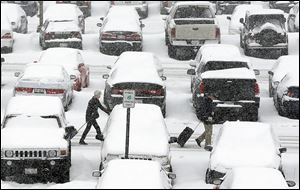
Feeling winter’s sting
3/10/2013
Travelers walk past snow-covered vehicles in the O'Hare International Airport parking lot in Chicago last week.
Global-warming skeptics are gleefully digging out after record snowfalls last week from Chicago to the East Coast. But the intensity of recent storms does not refute climate warnings. Rather, it reinforces the likelihood that the world’s climate is changing because of human activity — and not for the better.
Last Tuesday, Chicago recorded 6 inches of snow — a record for the date. Areas west of Washington, D.C., got about 11 inches as the storm moved east. Flood warnings were issued for areas of the East Coast as far north as Cape Cod, Mass.
More than 21 inches of snow fell in Wichita, Kan., in February. The total broke a monthly record that had stood for a century. More snow fell in one day in Amarillo, Texas, last month (19 inches) than the Panhandle city usually sees in a year (17.8 inches).
By mid-January, only 7 inches of snow had been recorded at Toledo Express Airport — less than half of the 16 inches Toledoans have come to expect by then. Temperatures, meanwhile, were averaging more than 5 degrees Fahrenheit above normal since Dec. 1.
February, by contrast, brought 12.4 inches of snow, 3 inches above normal. Still, Toledo is running more than 8 inches below normal for this time of year.
Is all this proof that global warming is bunk? Hardly. Weather is not climate, and no single storm or season can prove — or disprove — climate change.
But recent weather trends fit a pattern that scientists say will mean less moisture in general, including snow, but more intense storms when they do occur. There have been twice as many intense rain and snow events in the United States in the past 50 years as there were in the previous 60 years. At the same time, some parts of the Midwest are experiencing record droughts, and there is less moisture being stored in the mountain ranges of the American West and Northwest.
“The seasonal cycle is changing, and less of it is accumulating,” Sarah Kapnick, a Princeton University snowfall expert, told CNN.
But while some parts of the country are getting too little moisture, many parts are being hit by fiercer–than-normal weather events. Hurricane Sandy, which wreaked havoc from the Caribbean to New England, was such an event. Last week’s late-winter storm was another.
“Shorter snow season, less snow overall, but the occasional knockout punch,” climate scientist Michael Oppenheimer, also of Princeton, told the Associated Press. “That’s the new world we live in.”
The reason is simple. As you learned in Earth science, warmer-than-average air holds more moisture. When a front comes through with colder air, a lot of rain or snow results.
Researchers at Rutgers University say that more ground in the United States has been covered by snow in recent months than usual. But that snow layer is thinner than usual. The same is true of the Northern Hemisphere as a whole: less snow, but more intense and unique events.
Most researchers accept the reality of man-made global warming. They differ about what should be done, whether anything can be done, and sometimes whether it is even wise to stop world temperatures from rising.
But people in Amarillo, Wichita, Chicago, and anywhere along Hurricane Sandy’s path know that climate change can’t just be ignored.